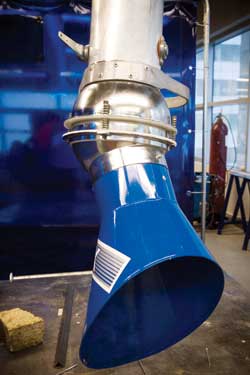Concordia Corner
All I need is the air that I breathe

An elephant trunk fume extractor keeps the air clear during welding in the Fine Arts metal shop.
Photo by Andrew Dobrowolskyj
There are elephant trunks in the Integrated Engineering, Computer Science and Visual Arts Complex (EV). At least, “That’s what some people call them,” explained Yves Gilbert, Director of Customer Service and Operational Development in Facilities Management.
The “trunks” are actually flexible fume extractors which extend down from the ceiling in places like the Fine Arts metal shop. “They can be positioned as needed,” said Gilbert, helping to remove the noxious and toxic by-products of processes such as welding. “They are very handy in places where other types of air extraction just won’t work,” he said.
The elephant trunks are one of several air extraction methods integrated into EV spaces where the chemicals and materials in use require more than normal venting.
As a multipurpose building containing offices, classrooms, labs, workshops, retail space and a gym, air flow in the EV Building was very carefully considered during design. In fact, from an intake perspective, the complex is actually two buildings.
“There are two fresh air supply systems,” said Gilbert, “one on the top of the engineering side, and the other on the top of the fine arts side.”
Indoors, each floor has independent, smart, mechanical rooms which draw in fresh air descending from the roof shaft and mixes it with recirculating air from the rest of the floor. “Carbon dioxide (CO2) sensors in the recirculating air return indicate the occupancy of the floor,” explained Gilbert; more CO2 means more people and more fresh air in the mix. Because fresh air has to be heated in the winter and cooled in the summer, the smart systems minimize energy use while ensuring good indoor air quality. “Generally we’re using about 80 per cent recirculated air.”
But none of the recycled air ever comes from labs or workshops. Here air is supplied as in all other spaces, but vented directly out of the building due to the chemicals and other materials. “It’s 100 per cent out,” said Gilbert.
In most labs and workshops even the constant venting isn’t enough. Spaces are equipped with additional air extractors, from elephant trunks to very high capacity fume hoods. One mechanical engineering lab has a fume hood that can vent 5,000 cubic feet per minute of “very, very stinky epoxy resin” said Dainius Juras (Technical Officer, Mechanical and Industrial Engineering).
He added that facilities are much improved over those in the Hall Building. “We used to have one fume hood, now we have nine. It’s just important in terms of health and safety.”
Between fine arts and engineering there are more than 40 fume hoods in the EV Building. They range from the traditional glass enclosed versions to slot hoods: thin openings in the wall that pull air horizontally away from a person’s breathing zone.
All of the lab air, and in fact all of the air slated to be expelled from the building, goes out through the same shaft. Here it is filtered for particulates (like sawdust) and run over a heat recovery coil containing glycol before being vented to the outside. There was a fire recently in the system, and Gilbert’s team is analyzing the situation to ensure that it does not happen again.